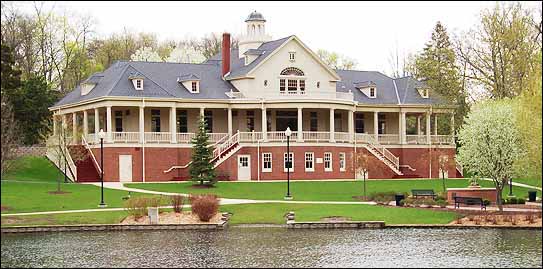
HISTORY OF MUSEUM AND LORDS PARK
The Museum
The natural history collection belonging to Mr. and Mrs. G. P. Lord was first exhibited in the Lords Park Pavilion in 1898. However, it was the Lords' desire that their collection be housed in its own building. In 1904 local architect David E. Postle was contracted to design a building to serve this purpose.
Construction of the current building's central structure began two years later, to be paid for in donations, the largest donation coming from the Lords. When Mr. Lord died in 1906, the center section of the building had been completed as well as the basement of the west wing, at a cost of $9,856. The following year, the metal roof covering the west basement was removed and the west wing was completed. However, after the death of Mr. Lord, interest in the project declined and the north and east wings of the building were not completed as originally planned. Further delays in opening the Museum were caused by breaks in the floor in 1908 and disagreements over hiring a full-time curator. The goal of housing a museum collection was forgotten as the building served as a storage place for hay from 1909-1911, and as the City Dog Pound, with animals being disposed of in the basement, from 1911-1917.
Originally named Lord Memorial Museum, the building finally opened on November 12, 1920 as the Elgin Audubon Museum, the Audubon Society having completed an agreement with the City of Elgin in 1917 to operate the Museum. The Audubon Society was to approve the curator and maintain the exhibits, while the City assumed the finances. The first curator was Charles J. Adkins, who served from 1920-1946, while at the same time working as Parks Caretaker until 1929. The exhibits and display cases, including those made to order by Rhineheimer's of Elgin, were moved from the Pavilion to the Museum; and in 1921 the Zeigler brothers donated additional cases. In 1933 the basement partitions, fireplace and restrooms were added as a government work project (WPA), at a cost of $2745.
When the Elgin Audubon Society disbanded in 1961, the City of Elgin's Department of Public Property and Recreation took over complete operation of the Museum. The Museum's name was changed to the Elgin Public Museum in 1975. Although lacking the balance of model in architectural integrity because the east wing was never built, the Museum was recognized by the National Registry of Historic Places as an example of Neo-Classical architecture, as well as for its local historical significance.
Finally in August of 1998 ground was broken to complete the east wing. The exterior of the east wing was built to match the original building. Architects Dalquist & Lutzow went so far as to match the brick and oolithic limestone detailing. The interior was built to complement the original design while keeping ADA (American's with Disabilities Act) requirements in mind.
The Elgin Public Museum reopened in July of 2000 with a handicapped accessible north entrance, elevator and public restrooms. New exhibits included Exploring the Waterways: The LaSalle Expedition, Nature of Elgin and a hands-on Children's Discovery Room. The Museum Store was expanded as well.
The Elgin Public Museum is now the oldest building in Illinois built expressly as a museum that is still serving that purpose. Its Neo-Classical style of architecture is unmistakable from the front with its two free columns and two square-engaged columns. Inside the Museum, visitors can still experience the beautiful and original oak woodwork, plaster wall ornamentation and ceramic tile floors.
The Lords Park
Lords Park is a beautiful 108-acre municipal park that features picnic areas, playgrounds, tennis and basketball courts, a family aquatic center, a nature trail and three lagoons.
Visitors can enjoy watching the American bison, elk, and white-tailed deer that live in wooded enclosures throughout the year. During the summer months, the Lords Park Farm Zoo features sheep, cattle, chickens, pigs, goats and more!
Lords Park was originally a farm owned by Dr. Joseph Tefft. In 1893, the property was purchased by George and Mary Carpenter Lord and presented to the City of Elgin as a gift with the agreement that the property would be used as a city park. The park was dedicated in 1898.
One century ago, the park featured two lagoons, a pavilion, pits for bears and other smaller animals, a large enclosure that housed deer, goats, peacocks, and other fancy fowls, and a building with glass sides that featured eagles and buzzards. Swings, teeters and sandboxes were installed in 1900.
The park we enjoy today has undergone many changes since its inception in the late 1800s. The original pavilion burned to the ground on September 30, 1897 and was replaced with the larger building known today as the Lords Park Pavilion. The bear cages were filled in and graded to the level of Willow Creek in 1969 and the eagles are gone.
However, the park's important place in urban life has not changed over the years. George P. Lord remarked in his speech at the dedication of the park in 1898, "... The park is designated as a public resting place, a place to which the people may resort for pleasure, rest and recreation. From this standpoint, who can estimate its value or have a just conception of the beauties that may be derived from frequent and prolonged visits to its cool and refreshing retreats?" This observation still rings as true today as it did over 100 years ago.
